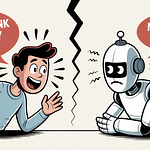The black box of AI is a favorite topic of mine, so much so that all of the "Additional Resources for Inquisitive Minds" listed today are created by me. Yes, apparently, I write about this topic a great deal.
So, how does AI "think?" Now, that is a terrible sentence and completely inaccurate. AI doesn't actually "think" (yet.) Why do AIs make the decisions they do?
In October 2023, we purchased our first Tesla. From the first day, I became obsessed with the decision-making capabilities of the car. As a lifelong nerd, driving a car that was essentially one big computer was endlessly fascinating.
Could the car learn over time if I drove the same route every day? What just changed with the latest software update? (The car gets software updates at least once or twice a month.) What is new and different about the car today? While software updates are great, the documentation is often scanty.
How much "smarter" did the car just get? If I don't know, then how can I trust the car in something as complex as an intersection? Or, a roundabout? Or, a right on red? Or, a highway on-ramp? Or, a school zone? These are very important questions as AI becomes more prevalent in our lives.
Unleashing My Inner AI Matchmaker: ChatGPT vs. Bard vs. Bing
My obsession with the car's AI naturally led to an obsession with another AI that launched a month later - ChatGPT. And, this got me interested in benchmarking one AI against another AI, so naturally I had to pit ChatGPT against Bard, and then Bard against Bing, and eventually Bard and Bing and Claude, etc. My fascination with the decision-making of AI comes down to the most fascinating paradox of AI models: the black box of AI models.
What is the Black Box of AI?
The "black box" of AI describes the opaque nature of many AI systems, particularly deep learning models. While these systems can produce remarkably accurate outputs, understanding how they arrive at these conclusions is often difficult. This lack of transparency can pose significant challenges, especially in fields where decisions need to be explained and trusted.
Why Does the Black Box Exist?
AI models, especially neural networks, involve complex layers of computations. Each layer extracts features from the input data and passes them on to the next, creating a web of interdependencies that are difficult to interpret. The more layers and parameters, the more intricate and obscure the model becomes.
Why Does It Matter?
Imagine an AI diagnosing a rare disease, advising on stock investments, or navigating city streets autonomously. These decisions are accurate but inexplicable, leading to significant challenges when humans can't understand the reasoning.
For example, my not-so-self-driving car can make split-second decisions, yet I don't always know why it is making these decisions. The obscure logic behind these actions hinders trust.
Unpacking the Black Box
Efforts to make AI's decision-making process more transparent include:
- Explainable AI (XAI): Techniques and tools designed to make AI decision-making more understandable to humans. For instance, visualizations that show which parts of an input image most influenced a model's decision, helping users understand the factors contributing to the AI's output.
- Model Simplification: Developing simpler models that are easier to interpret, even if it means sacrificing some performance.
- Post-Hoc Analysis: Analyzing the model's behavior after it has made decisions to understand its patterns and reasoning.
Challenges and Future Outlook
Despite significant advancements, making AI fully transparent remains a daunting task. Future research aims to balance performance with interpretability, ensuring that AI systems are both powerful and understandable. Ethical considerations, such as ensuring fairness and preventing bias, and regulations aimed at promoting transparency and accountability will also play a crucial role in guiding these developments.
Final Thoughts
The black box of AI is a critical issue that demands ongoing attention. As we continue to rely more on AI systems, understanding their inner workings will be essential to ensure fairness, accountability, and trust.
Crafted by Diana Wolf Torres, a freelance writer, harnessing the combined power of human insight and AI innovation.
Stay Curious. Stay Informed. #DeepLearningDaily
Vocabulary Key
- Neural Networks: A type of AI model inspired by the human brain, consisting of layers of interconnected nodes.
- Parameters: Variables within the model that are adjusted during training to minimize error.
- Explainable AI (XAI): A subfield of AI focused on making AI systems more interpretable and understandable.
Additional Resources for Inquisitive Minds:
The Black Box Problem in AI: A Historical Perspective. Diana Wolf Torres. Deep Learning Daily.
Beyond the Black Box: Understanding AI's Recommendations. Diana Wolf Torres. Deep Learning Daily.
A Peek Inside the AI Black Box: Anthropic Uncovers Millions of Concepts in Language Model. Diana Wolf Torres. Deep Learning Daily.
Unraveling the Paperclip Alignment Problem: A Cautionary Tale in AI Development. Diana Wolf Torres. Deep Learning Daily.
Video: AI History Lesson: The Evolution Behind the Black Box. @DeepLearningDaily podcast on YouTube. Diana Wolf Torres.
Video: Strange Behaviors By AI. @DeepLearningDaily podcast on YouTube. Diana Wolf Torres.
Video: The "Black Box of AI." @DeepLearningDaily podcast on YouTube. Diana Wolf Torres.
I am now on Spotify.
Follow me as "Deep Learning With the Wolf."
Coming soon on Apple Podcasts.
#ArtificialIntelligence #AI #BlackBoxAI #ExplainableAI #MachineLearning #DeepLearning #AIEthics #TechTransparency #HealthcareAI #FinanceAI #AutonomousVehicles #Podcast

















Share this post